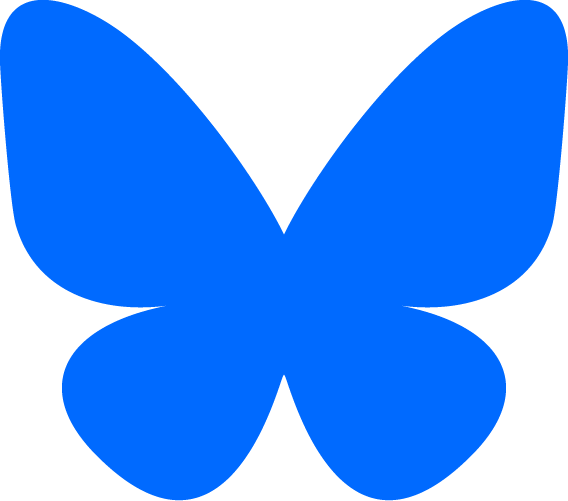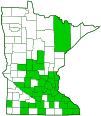Virginia Opossum
(Didelphis virginiana)
Conservation • Description • Habitat • Ecology • Distribution • Taxonomy
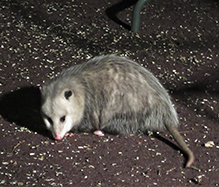
Conservation Status
IUCN Red List
LC - Least Concern
NatureServe
N5 - Secure
SNR - Unranked
Minnesota
not listed
Description
Virginia Opossum is the largest opossum in the world and the only marsupial in North America.
In northern states the undercoat is white and the guard hairs are tipped with black, resulting in an overall whitish-gray appearance. The tail is prehensile and naked. The basal third to half of the tail is black, the rest white. It is sometimes shortened from being partially frozen off.
The muzzle is long and narrow. The face is white. The ears are naked, paper thin, and black with a white tip. They are often shortened from being partially frozen off.
Size
Head and body: 17″ to 21½″
Tail: 10¼″ to 13¾″
Sign
Tracks
The front foot makes a star-like print with five toes pointing in different directions. The opposable thumb on the hind foot may point at right angles or even in the opposite direction of the rest of the toes. That thumb has no nail. The rear print is next to or partially covering the front print.
Dens
Opossums
generally use the den of another animal, usually after it has been abandoned, sometimes chasing the original owner out. They do not dig their own dens.
Similar Species
Habitat
Deciduous and mixed forests and woodlands, brushy areas, agricultural areas, old fields
Ecology
Behavior
Virginia Opossum is usually active only at night.
When threatened it may feign death. This is the origin of the term “playing possum”.
Lifespan
About 2 years in the wild
Life Cycle
Food
Insects and other invertebrates, small birds and mammals, frogs, carrion, bird eggs, fruits, grains, and human garbage.
Distribution |
||
|
Sources Biodiversity occurrence data published by: Minnesota Biodiversity Atlas (accessed through the Minnesota Biodiversity Atlas Portal, bellatlas.umn.edu, 12/20/2025). Hazard, Evan B. 1982. The Mammals of Minnesota. University of Minnesota Press, Minneapolis, Minnesota. 280 pp. The counties in light green lack modern records but have historic county or township specimens or records. |
|
| 12/20/2025 | ||
Occurrence |
||
Common in the southern third of Minnesota, uncommon farther north, absent from the coniferous forest |
||
Taxonomy
Class
Subclass
Theria
Infraclass
Marsupialia (Marsupials)
Superorder
incertae sedis (uncertain placement)
Order
Didelphimorphia (Opossoms)
Family
Didelphidae (Opossoms)
Subfamily
Didelphinae (Large American Opossums, Mouse Opossums, and Allies)
Tribe
Didelphini (Large New World Opossums)
Genus
Didelphis (Large American Opossums)
Subordinate Taxa
Florida Opossum (Didelphis virginiana pigra)
North Mexican Opossum (Didelphis virginiana californica)
Virginia Opossum (Didelphis virginiana virginiana) ![]()
Yucatán Opossum (Didelphis virginiana yucatanensis)
Synonyms
Didelphis marsupialis virginiana
Common Names
Eastern Virginia Opossum
North American Opossum
Opossum
Possum
Virginia Opossum
Visitor Photos
Share your photo of this mammal.
This button not working for you?
Simply email us at info@MinnesotaSeasons.com.
Attach one or more photos and, if you like, a caption.
Bobbi Johnson |
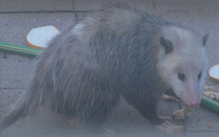 |
Ramona Abrego |
||
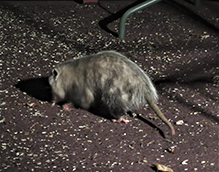 |
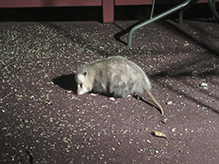 |
|
 |
||
MinnesotaSeasons.com Photos
|

Slideshows

Visitor Videos
Share your video of this mammal.
This button not working for you?
Simply email us at info@MinnesotaSeasons.com.
Attach a video, a YouTube link, or a cloud storage link.
Other Videos
Virginia Opossum - HD Mini-Documentary
James Knott
Opossum, Where Art Thou? Rescue, Rehab, and Release
The Humane Society of the United States
Adventures with Swamp Girl! Virginia Opossum!
Swamp Girl
Another Opossum
alicechaos
Virginia Opossum
KathyChlumsky

Visitor Sightings
Report a sighting of this mammal.
This button not working for you?
Simply email us at info@MinnesotaSeasons.com.
Be sure to include a location.
Duane Klooz
7/11/2021
Location: 2527 16th Ave S, Minneapolis, MN 55404
first sighted in April. Since then I've discovered that theirs a family of them Residing under my neighbors house. For sure there are at least 3 possiums. Perhaps more I'm not sure. I just seen a baby walking thru my back yard. There it was, spotted it in the corner of my eye. As I was putting mimzy down (my Chihuahua) to potty. Sudden change of plans. Straight back inside we went.. I Literally live 10 ft from the house next door further more, under my other neighbors front porch is a family of raccoons. All the gunshots lately in My neighborhood along with the mammals prowling late at night keeps me from having fun after dark.
Lila
7/31/2018
Location: Edina
We saw a large opossum crossing the street into a neighbors yard. It went into the bushes.
Iron Skye
6/5/2018
Location: Minneapolis, MN
I live in South Minneapolis about 10 city blocks due east if I35W. This animal was seen on the 4400 block of Columbus Avenue for the second time this week, both times at about 11:30pm.
Gary Larson
10/23/2015
Location: Burnsville/Lakeville border edge Buck Hill
Minnesota Seasons Sightings




